Turn your late summer harvest of chokecherries into delicious chokecherry syrup! This syrup is from a family recipe, and tastes delicious over pancakes, waffles, ice cream, in drinks, and more. Our recipe requires no pectin and uses just chokecherries, sugar, and water.
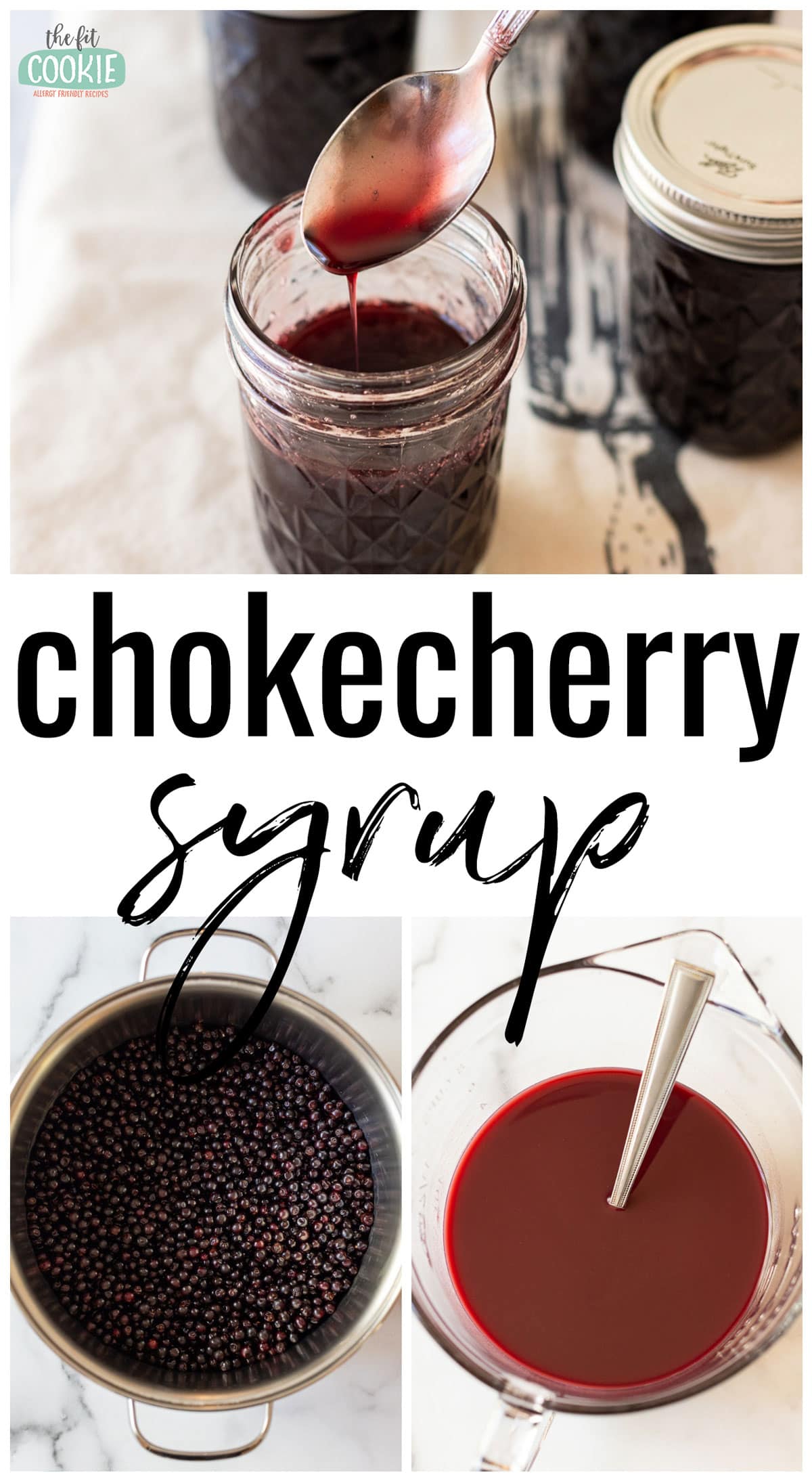
If you’ve followed The Fit Cookie for a while, you know that I love sharing some of our family recipes or the recipes we used to make when I was a kid. One of our family favorite recipes I’m sharing today is chokecherry syrup.
Chokecherry syrup has been a staple in our home growing up for as long as I can remember. Chokecherries are a puckery/mouth drying fruit (thanks to tannins) with kind of an earthy fruit taste that’s very familiar but hard for me to describe. It’s very different than the fruity flavors you get from fresh strawberries or raspberries.
This recipe for chokecherry syrup is one that I adapted from a recipe that my mom uses and got from my grandma, who had gotten the recipe from an old cookbook. I made a few adjustments and had a few mess ups, and wrote it down in a recipe for you all!
Why we love this recipe
Chokecherry syrup is used just like you’d use other fruit syrups (like blueberry syrup), it’s so yummy over things like pancakes, waffles, ice cream, cheesecakes, and more.
My favorite way to eat chokecherry syrup is over pancakes in the morning, this is how I used to eat it the most growing up and still my favorite way to use it now. But you can get creative with this syrup and use it in things like milkshakes, cocktails or mocktails, and other recipes.
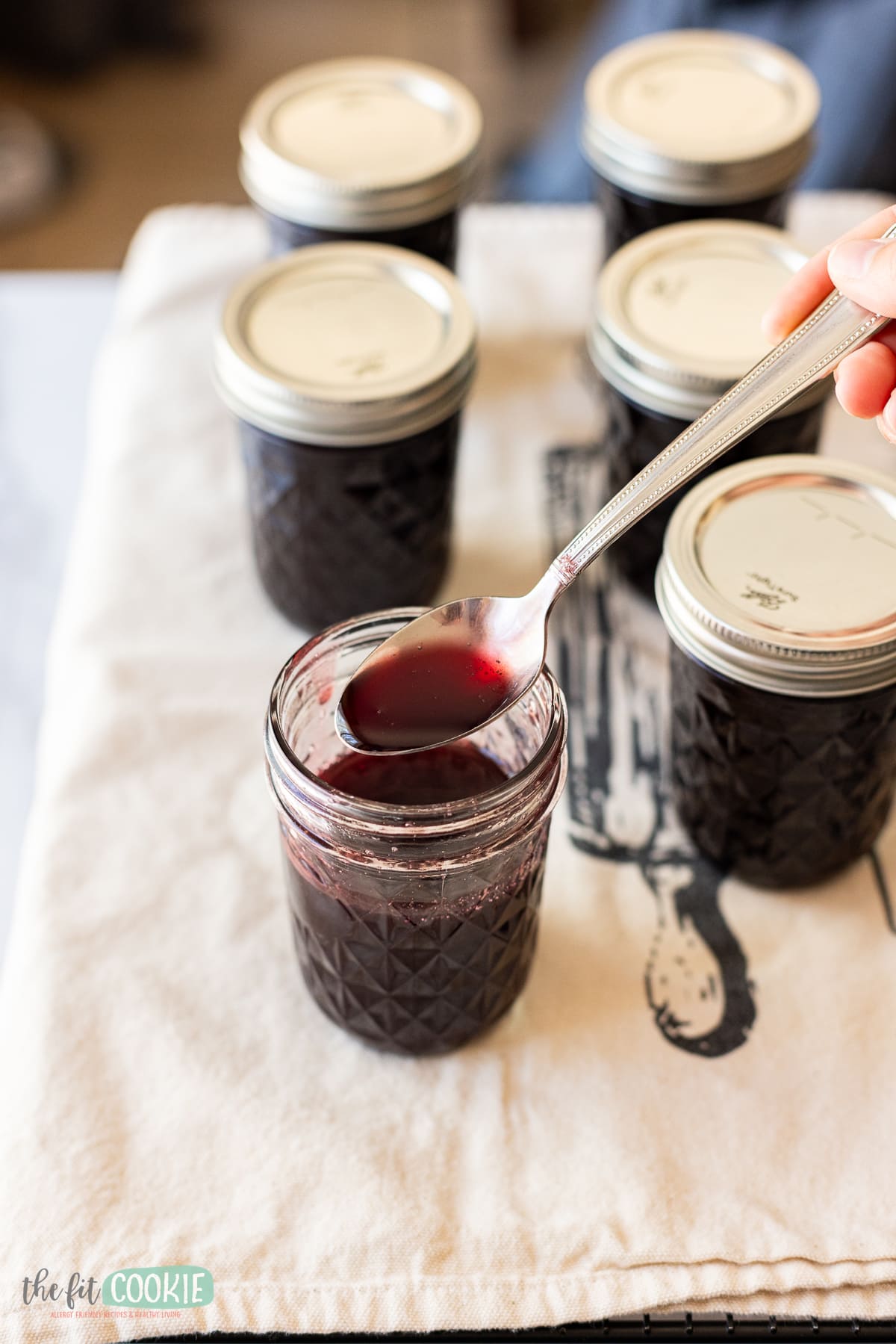
What are chokecherries?
Chokecherry (Prunus virginiana) is a tree (can also look shrubby) that produces small, dark reddish purple berries that are often used for making jelly, syrup, or mixed with other fruits like apples for sauces.
Chokecherries can grow naturally between zones 2 to 7, and even up to zone 10, they are native to North America and found in 44 states and Canada. Chokecherries (Prunus virginiana) are not the same as chokeberries (Aronia melanocarpa, also called aronia berries) which are distantly related to chokecherries and are also edible but not the same fruit.
A few other names for chokecherries are bitter-berry, Virginia bird cherry, and western chokecherry. Late summer is usually the time chokecherries are ripe, depending on the elevation. We live at 4500 feet elevation and they’re usually ripe for picking in August, but at higher elevations it might take a little longer for them to be ready to pick.
Many Native American tribes have historically included chokecherries in their diets, adding them to stews, cakes, pemmican, and many other dishes and drinks, and sometimes just drying them for eating later. While they often ate the seeds with the chokecherries, the toxicity of the seeds were eliminated or reduced by the cooking or drying process (more on that below).
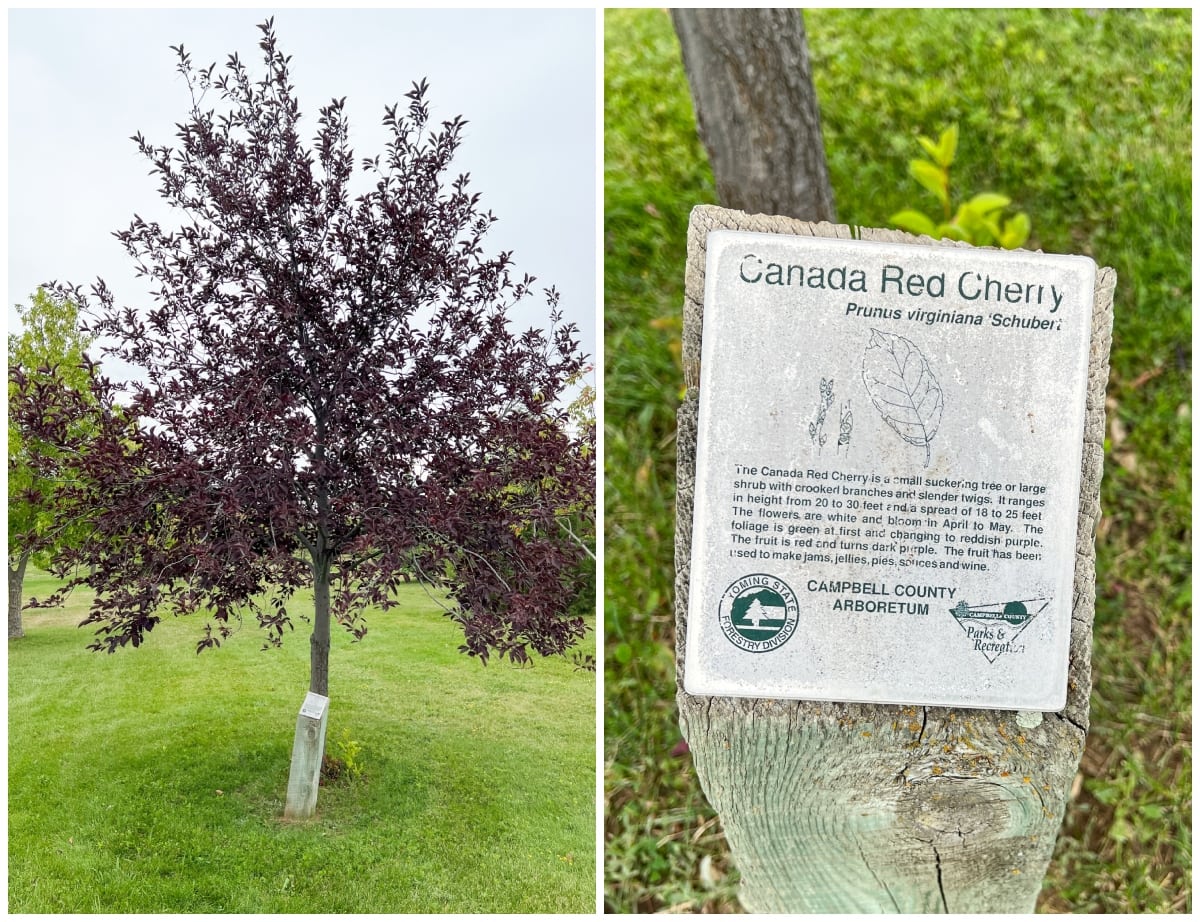
We have a red leaf variety of chokecherry tree in our backyard, which is a Canada Red chokecherry variety (also called Schubert variety). The leaves start out as green and turn purple-red later in the summer.
Here’s a close up of the leaves from the tree in our backyard:
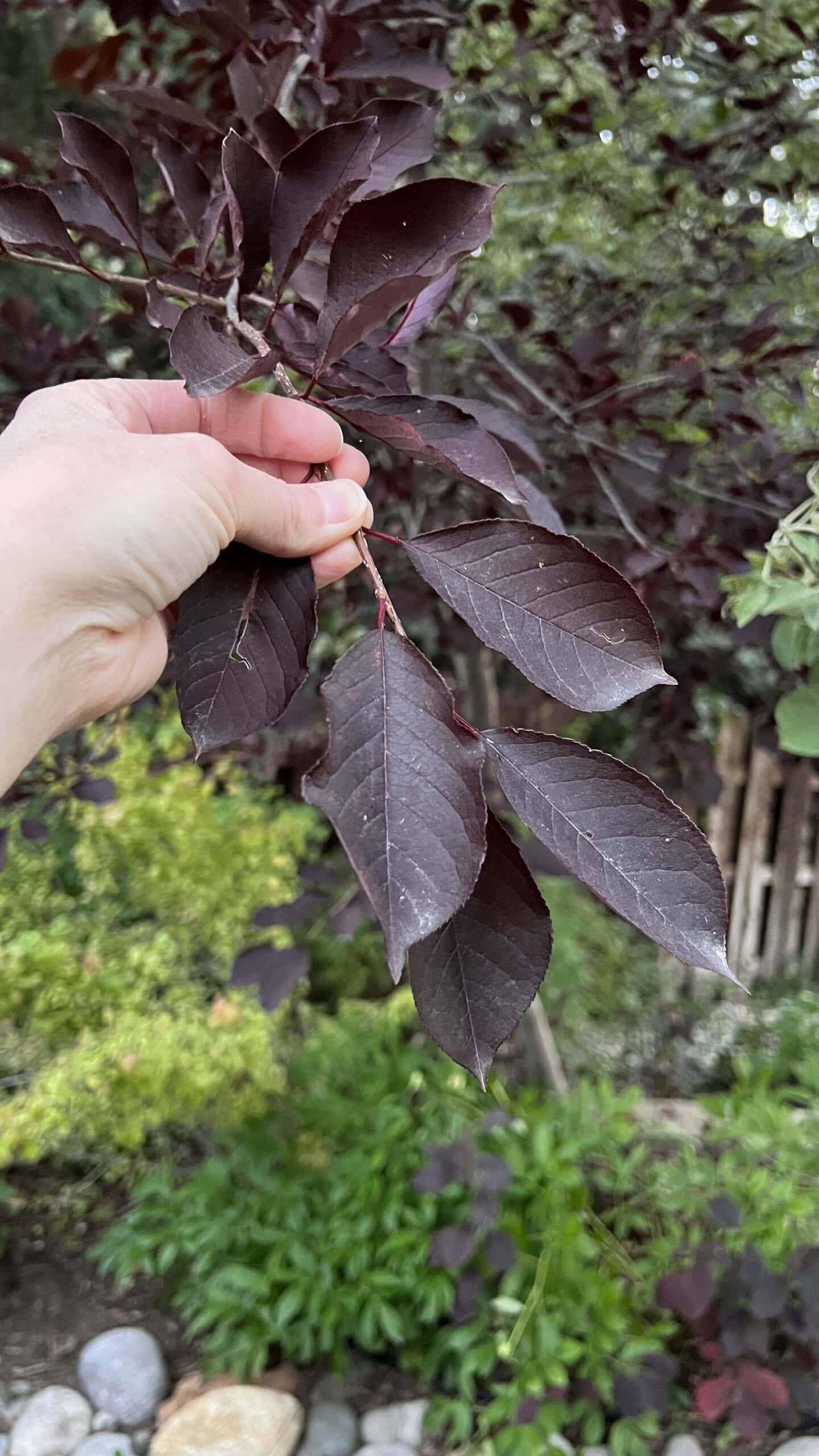
Most of the wild chokecherries we’ve collected have been from trees or shrubs with green leaves, and most of the chokecherry trees in the yards and parks here are the Canada Red/Schubert variety. So there are a few different domestic and wild varieties of chokecherry trees and shrubs.
You can see what chokecherries look like when they grow in clusters on the tree. I couldn’t find any trees here that still had chokecherries on them for a photo when I posted this, so I’ll have to get a photo from our tree next year.
Make sure to positively identify any plant before collecting and eating the fruit, especially if it’s raw. Oregon State University and the USDA have good info on how to identify chokecherry trees.
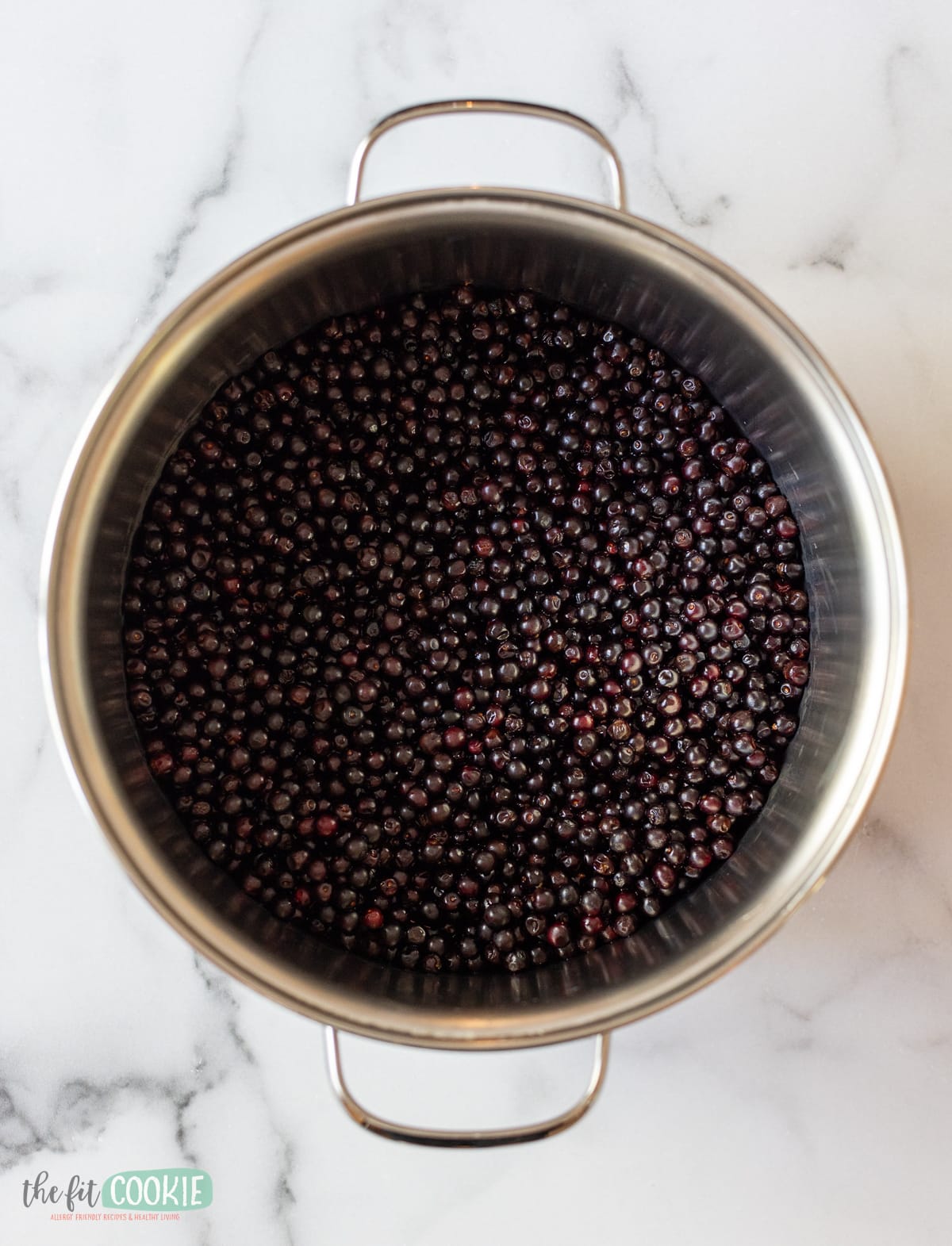
Are chokecherry seeds toxic?
Similar to a lot of other fruits, like peaches, cherries or apples, the raw seeds of chokecherries contain natural compounds known as amygdalin which can break down into cyanide compounds when ingested.
The raw leaves and stems of chokecherries are also toxic as well, although this is more of an issue for livestock than humans since people don’t tend to eat the raw leaves and stems from chokecherries.
In general, consuming small amounts of raw chokecherry seeds is unlikely to cause harm because the levels of cyanide produced would be fairly low, like accidentally eating a couple apple seeds won’t usually cause an issue.
However, consuming large quantities of raw and crushed seeds could potentially lead to cyanide toxicity.
This is why it’s important to cook the fruit first and use a food mill or steel cone and pestle set for pressing juice from chokecherries, vs using something like a blender with raw fruit to extract the juice. A food mill will not crush or break the seeds, whereas a blender will, releasing the amygdalin.
While cooking and drying can neutralize amygdalin and potential toxicity (such as the way the Native Americans prepared their chokecherries), I really am not sure at what temperatures and cooking times the toxicity is reduced or eliminated, so it’s still best to avoid crushing the chokecherry seeds into your juice for jellies or syrups.
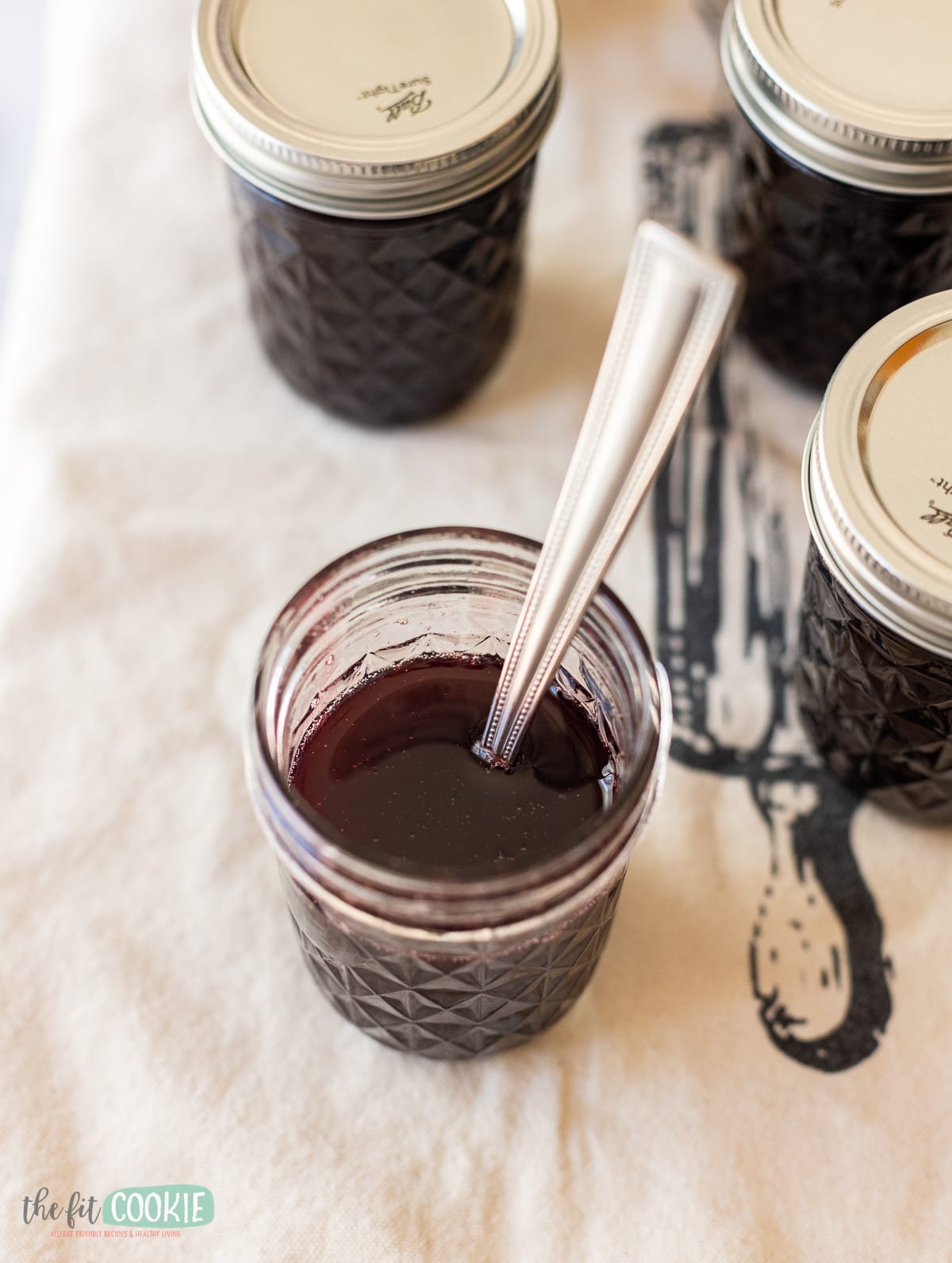
A few broken seeds shouldn’t be an issue, especially if the fruit has been cooked, but don’t put several pounds of raw chokecherries in a blender to make juice (speaking from experience). Which leads me to a related side story…
Don’t use a blender to get juice from raw chokecherries
When I was trying to make chokecherry juice one day I put the raw, uncooked chokecherries in a blender with some water to strain out for juice to add to lemonade (similar to how I process raspberries for lemonade), not realizing at the time that the raw chokecherry seeds are toxic.
Once I put everything through the blender and strained the juice, I noticed a strong almond scent, which gave me pause. This isn’t a normal smell for chokecherries and made me realize that the seeds were probably toxic, so I looked it up online and sure enough they were.
The almond scent comes from benzaldehyde, which is another byproduct of amygdalin (benzaldehyde is often used in almond extracts). Obviously not everything almond scented will have amygdalin or the potential for cyanide toxicity. But since I had just crushed the raw fruit (including the seeds), I knew something wasn’t quite right for it to have that strong almond extract smell.
Not sure how I never knew before that chokecherry seeds were toxic, I probably didn’t pay attention to that part when we made chokecherry syrup and jelly as kids. But I fortunately made the realization before I added the raw juice (that had been mixed with the crushed seeds) into my lemonade.
I’m really not sure if it would have been enough to made us sick, but at any rate I’m glad I hesitated when I smelled the very strong almond scent from my raw chokecherry juice. Chokecherry seeds take up a lot of the fruit (probably 1/3 to 1/2 of the chokecherry is actually the seed), so it can add up if you have several pounds of chokecherries.
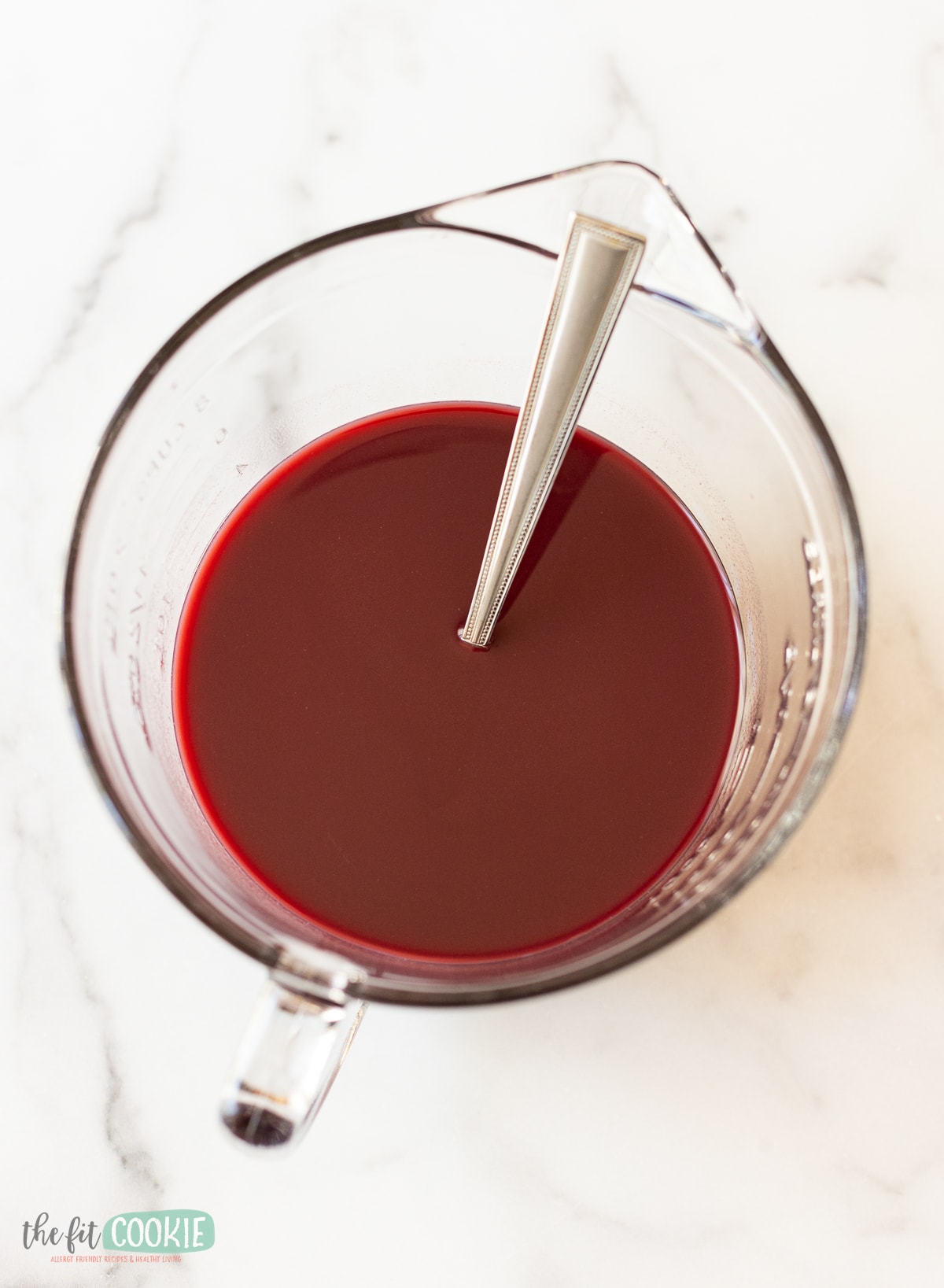
Interestingly enough, my son smelled cherries when he smelled the chokecherry pulp, while I smelled almonds. Both cherry extract and almond extract use benzaldehyde so they have similar scent and flavor profiles.
Chokecherries are a safe and delicious fruit when cooked and prepared properly. Don’t do what I mistakenly did early on and try to make chokecherry juice by blending raw berries with water.
How to make chokecherry syrup
Now that we’ve covered my past blunders as a useful lesson in what not to do, let’s go through the proper steps for making chokecherry syrup (this is just an overview, the full recipe card is at the end of the post).
I recommend reading through the steps completely before starting to make your syrup.
- Collect your ripe chokecherries in a bucket or bowl, look for fruit that is dark purple and smooth, not mushy or wrinkled.
- Sort through/pick through the berries in your bowl or bucket and remove leaves, stems, and any mushy or under ripe berries.
- Fill the bucket or bowl with water and shake swirl the berries in the water, letting any additional stems, leaves, etc. rise to top and then dump off this water. Repeat as many times as needed (I did mine 2-3 times).
- Put about 1-2 cups of chokecherries in a strainer to rinse through berries in a stainer, picking through them again if needed to remove any bad berries, stems, or leaves.
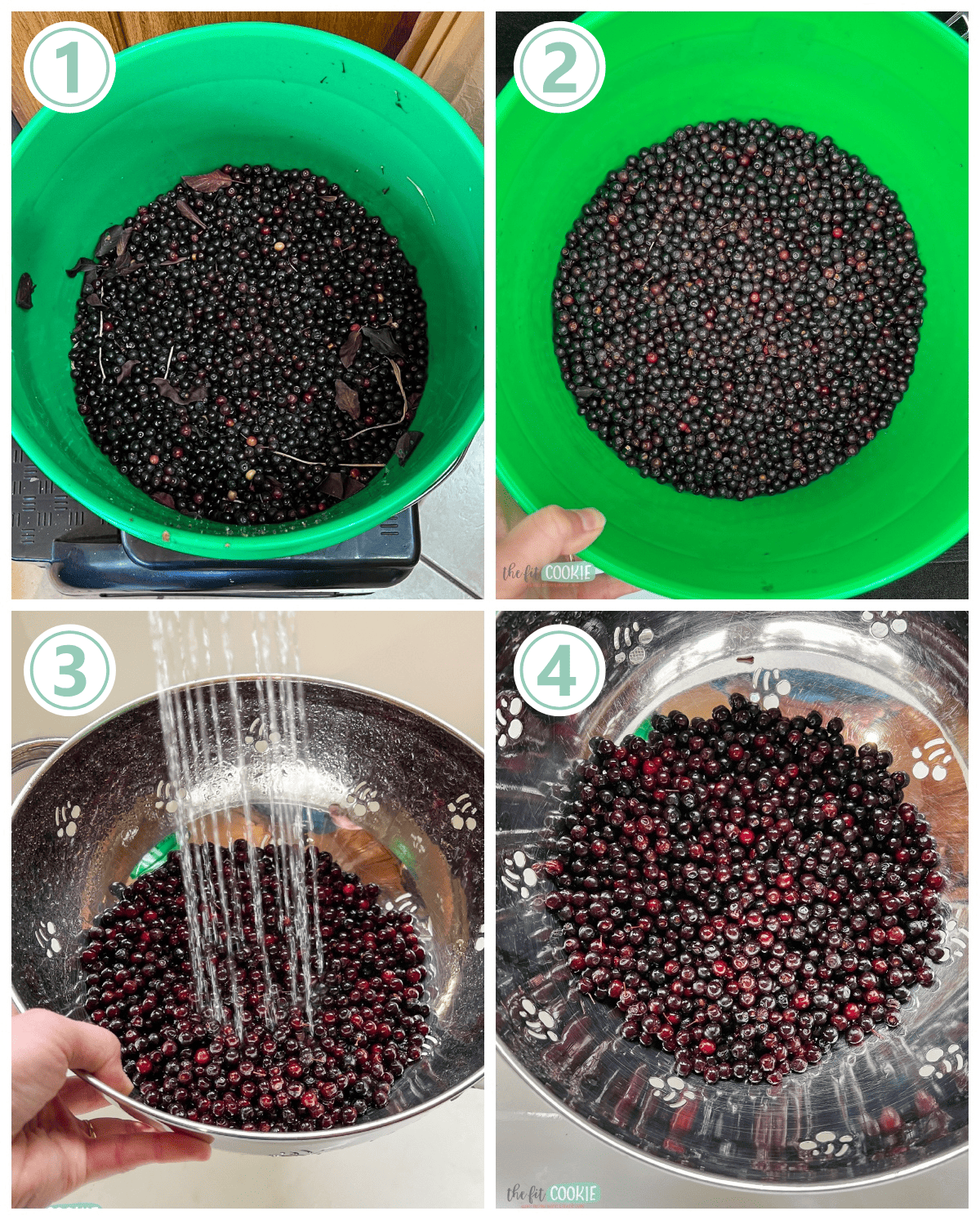
- Add 3 pounds of sorted berries (about 7 cups of berries) to a pot and cover with water about 1/2 to 1 inch above the berries (about 3-4 cups of water).
- Heat the water and chokecherries until boiling, reduce the heat slightly to just below medium heat, cover, and simmer for about 15-20 minutes or so, scooping off foam that forms on top as needed. Add a little hot water to the pot as needed to make sure the berries stay covered with water as they cook.
- Press the cooked berries and the cooking water through a food mill, or a cone and pestle, or a metal mesh strainer, to press the juice out of the berries. Discard the seeds and skins left behind.
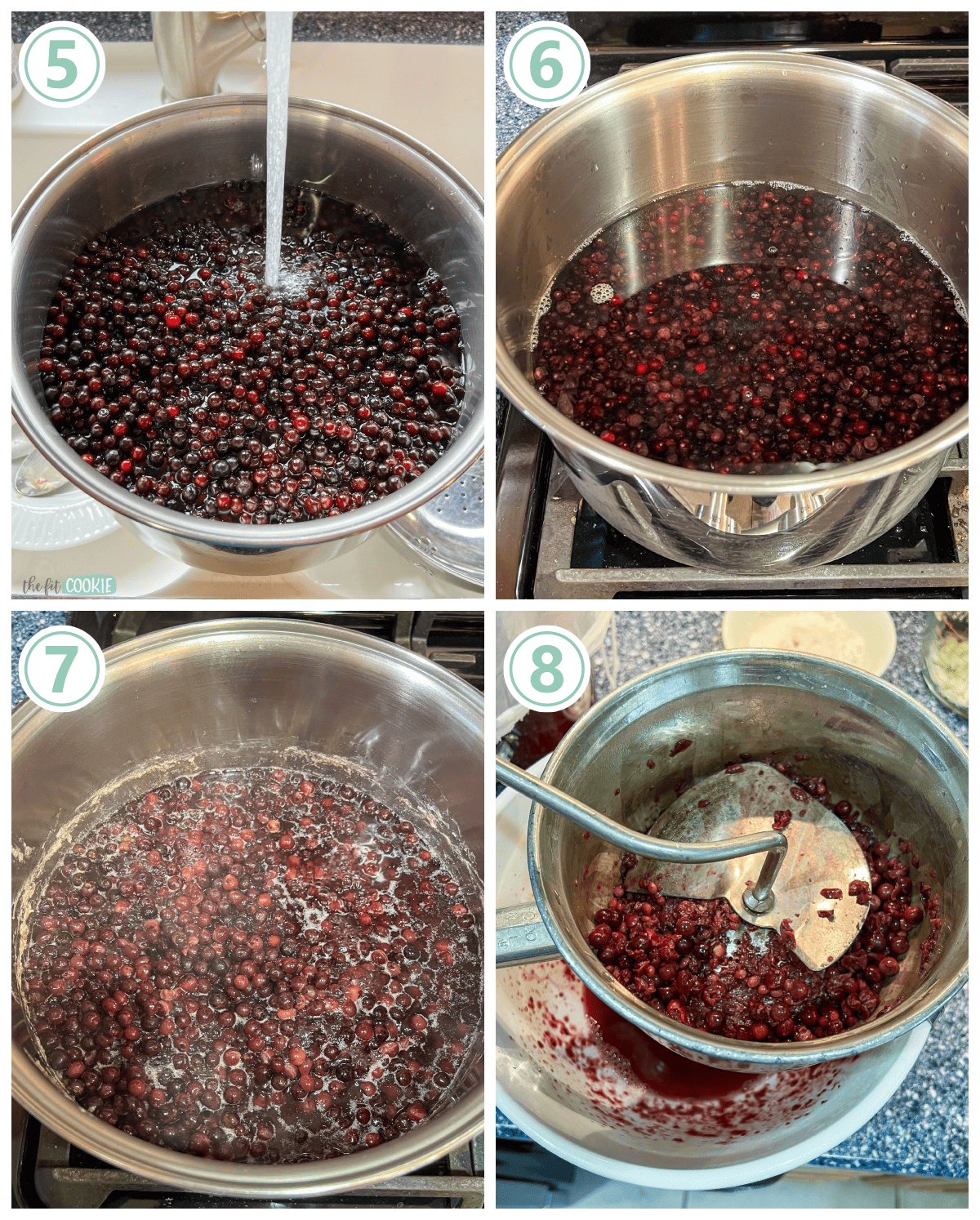
- Pour the juice through a juice bag or nut milk bag to strain out any pulp that made it through the food mill or strainer.
- I got about 3 ¼ cups juice from my 3 pounds of chokecherries and cooking water. Cook 3 ¼ cups chokecherry juice to 4 ¼ cups sugar in a large pot until everything is dissolved and the mixture begins to boil.
- Simmer the syrup uncovered for 10 minutes to thicken the syrup, stirring occasionally, scooping off any foam that rises to the top. I like my syrup thicker, so 10 minutes works good for me, but you can cook this less (like 5 minutes or even less) if you don’t want a thick syrup.
- If you end up with a different amount of juice than 3 ¼ cups, use the ratio of 1.3x sugar to juice for the syrup. So for every 1 cup of chokecherry juice, you’ll use 1 ⅓ cup sugar.
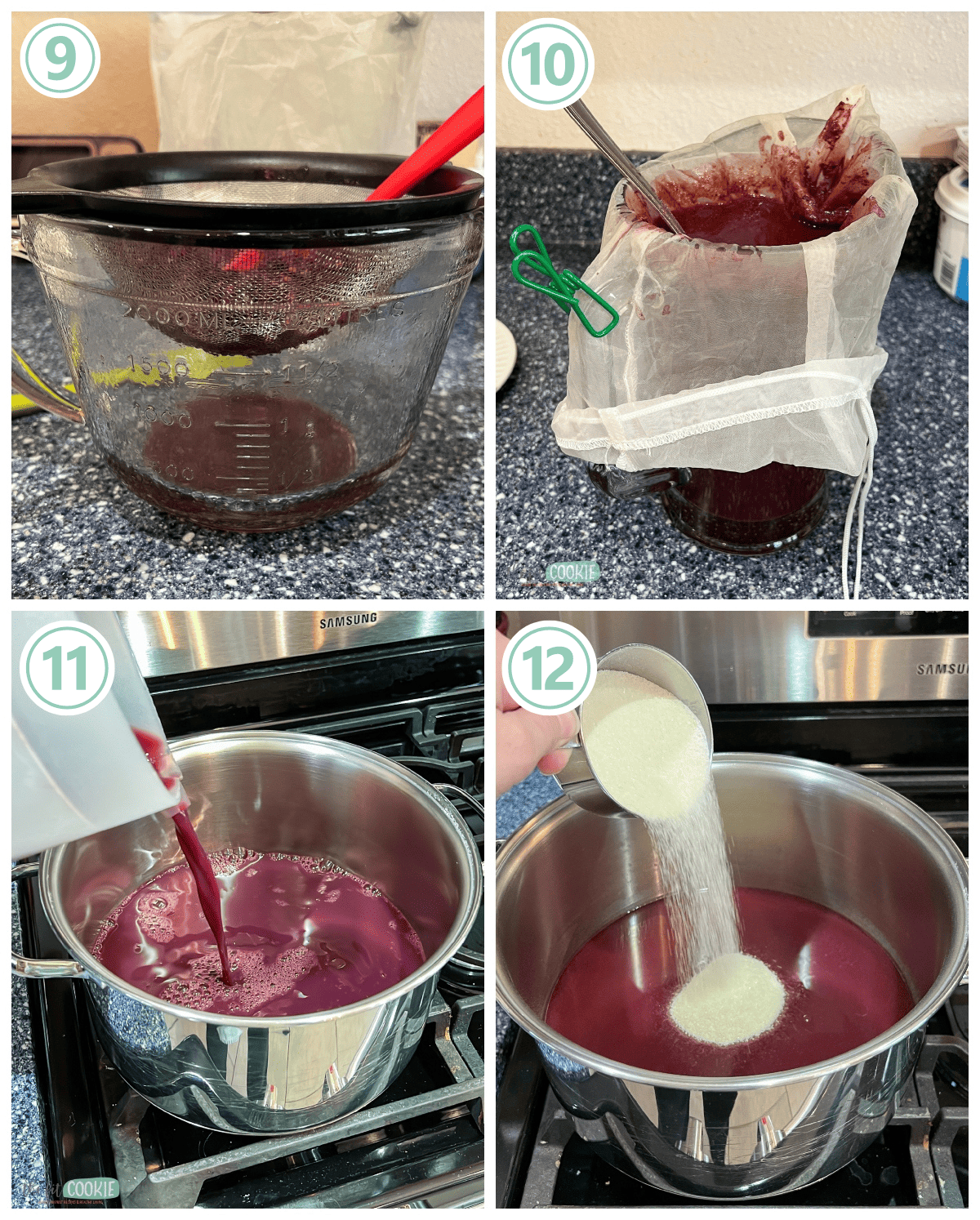
- Test taste the syrup (make sure your tasting sample is completely cooled) and if you need a little more tartness to the syrup, you can add a little lemon juice to adjust the tartness and sweetness. My first batch I added a little lemon juice, but with my second batch I didn’t need it.
- Once the syrup is done cooking, take it off the heat and add it to jars for either canning or freezing. I’ve included the canning steps below.
I recommend using a food mill vs a steel cone or a wire mesh strainer to separate your seeds and get juice since it goes much faster, but if you don’t have a food mill, the mesh strainer is my next choice since I still think it works better than the steel cone and pestle.
To freeze this syrup, add to clean jars leaving enough space at the top of the jar (about 1/2 to 1 inch) for expanding liquid as it freezes.
If you plan on canning this syrup vs just freezing it, here are the steps for canning your chokecherry syrup:
- Prepare your canning pot with enough water to cover your empty jars and heat to boiling (I usually start heating the canning water when I start making my syrup).
- Sterilize about 5 to 6 8-ounce jars for 10 minutes in boiling water. According to new Ball canning recommendations, the lids and rings don’t need to be sterilized, just washed in hot soapy water.
- Put syrup into the hot sterilized jars leaving about 1/4 to 1/2 inch headspace and secure lids fingertip tight.
- Add the jars of syrup to the hot water bath (making sure the water covers the jars by at least 1 inch) and boil for 10 minutes.
- Remove the jars to a cooling rack and allow to cool completely. Check lid seals after 12-24 hours and store in a cool place out of direct sunlight.
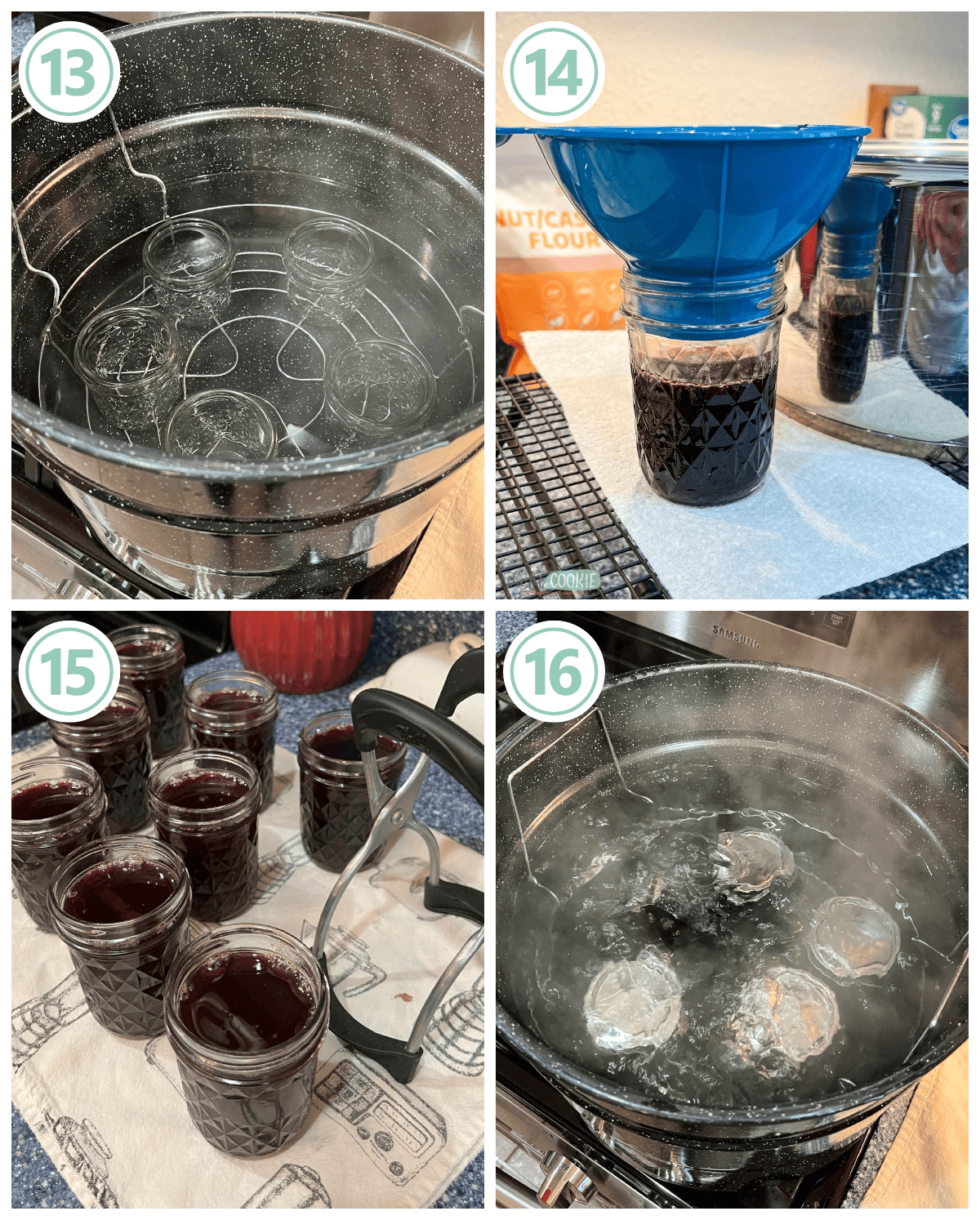
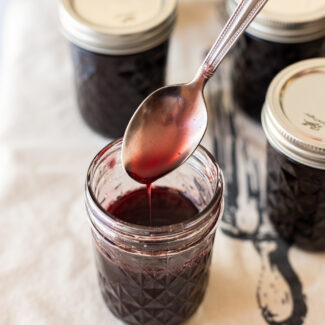
Homemade Chokecherry Syrup
Ingredients
- 3 pounds fresh chokecherries that have been picked through (about 7 cups of chokecherries)
- Water to cover chokecherries (about 3-4 cups)
- 4 ¼ cup unbleached sugar (or regular white sugar)
- Lemon juice, optional if you want more tartness
Equipment
- Jelly/juice bag, (or nut milk bag)
- Large cooking pot
Instructions
Chokecherry syrup
- Collect your ripe chokecherries in a bucket or bowl, look for fruit that is dark purple and smooth, not mushy or wrinkled.
- Sort through/pick through the berries in your bowl or bucket and remove leaves, stems, and any mushy or under ripe berries.
- Fill the bucket or bowl with water and shake swirl the berries in the water, letting any additional stems, leaves, etc. rise to top and then dump off this water. Repeat as many times as needed (I did mine 2-3 times).
- Put about 1-2 cups of chokecherries in a strainer to rinse through berries in a stainer, picking through them again if needed to remove any bad berries, stems, or leaves.
- Add 3 pounds of sorted berries to a pot and cover with water about 1/2 to 1 inch above the berries (about 3-4 cups of water).
- Heat the water and chokecherries until boiling, reduce the heat slightly to just below medium heat, cover, and simmer for about 15-20 minutes or so, scooping off foam that forms on top as needed. Add a little hot water to the pot as needed to make sure the berries stay covered with water as they cook.
- Press the cooked berries and the cooking water through a food mill, or a cone and pestle, or a metal mesh strainer, to press the juice out of the berries. Discard the seeds and skins left behind.
- Pour the juice through a juice bag or nut milk bag to strain out any pulp that made it through the food mill or strainer.
- I got about 3 ¼ cups juice from my 3 pounds of chokecherries and cooking water. Cook 3 ¼ cups chokecherry juice to 4 ¼ cups sugar in a large pot until everything is dissolved and the mixture begins to boil.
- Simmer the syrup uncovered for 10 minutes to thicken the syrup, stirring occasionally, scooping off any foam that rises to the top. I like my syrup thicker, so 10 minutes works good for me, but you can cook this less (like 5 minutes or even less) if you don’t want a thick syrup.
- If you end up with a different amount of juice than 3 ¼ cups, use the ratio of 1.3x sugar to juice for the syrup. So for every 1 cup of chokecherry juice, you’ll use 1 ⅓ cup sugar.
- Once the syrup is done cooking, take it off the heat and add it to jars for either canning or freezing.
- Test taste the syrup (make sure your tasting sample is completely cooled) and if you need a little more tartness to the syrup, you can add a little lemon juice to adjust the tartness and sweetness. My first batch I added lemon juice, but with my second batch I didn't need it.
Canning instructions
- Prepare your canning pot with enough water to cover your empty jars and heat to boiling (I usually start heating the canning water when I start making my syrup).
- Sterilize about 5 to 6 8-ounce jars for 10 minutes in boiling water. According to new Ball canning recommendations, the lids and rings don't need to be sterilized, just washed in hot soapy water.
- Put syrup into the hot sterilized jars leaving about 1/4 to 1/2 inch headspace and secure lids fingertip tight.
- Add the jars of syrup to the hot water bath (making sure the water covers the jars by at least 1 inch) and boil for 10 minutes.
- Remove the jars to a cooling rack and allow to cool completely. Check lid seals after 12-24 hours and store in a cool place out of direct sunlight.
Video
Notes
Nutrition
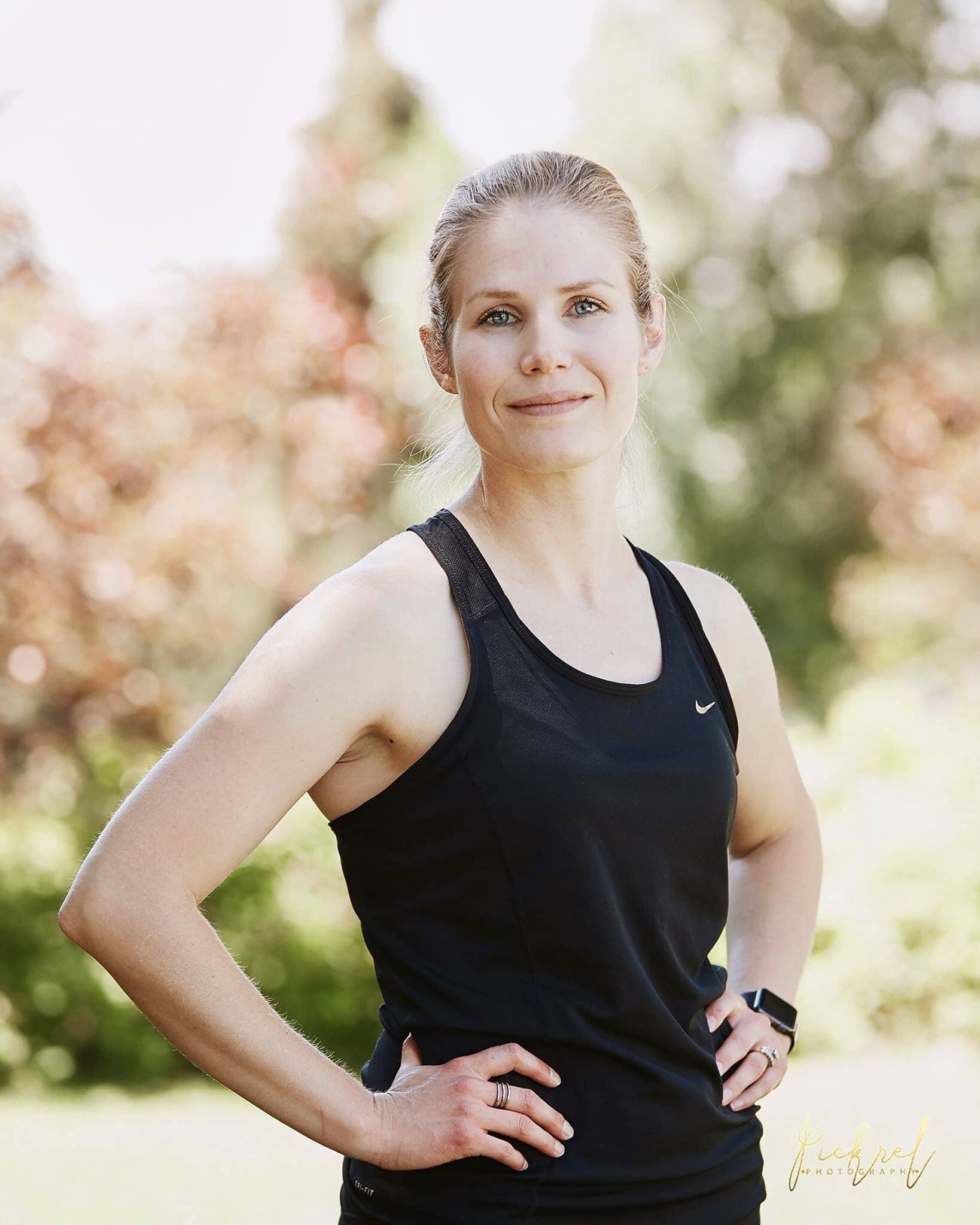
Sarah Jane Parker is the founder, recipe creator, and photographer behind The Fit Cookie. She’s a food allergy mom and healthy living blogger based in Wyoming. Sarah is also an ACSM Certified Personal Trainer, ACE Certified Health Coach, Revolution Running certified running coach, and an ACE Certified Fitness Nutrition Specialist
